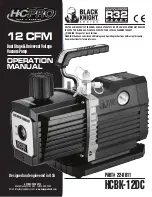
EMRQ8~16ABY1
Daikin Altherma outdoor unit
4P501819-1 – 2017.08
Installation manual
16
4.
Branching the refrigerant piping
For installation of the refrigerant branching kit, refer to the
installation manual delivered with the kit.
Follow the conditions listed below:
■
Mount the refnet joint so that it branches either horizontally or
vertically.
■
Mount the refnet header so that it branches horizontally.
10.3. Guidelines for handling stop valve
Cautions on handling the stop valve
■
Make sure to keep both stop valves open during operation.
■
The figure below shows the name of each part required in
handling the stop valve.
■
The stop valve is factory closed.
How to use the stop valve
Opening the stop valve
1.
Remove the valve cover.
2.
Insert a hexagon wrench (liquid side: 4 mm, discharge side:
8
mm) into the stop valve and turn the stop valve
counterclockwise.
3.
When the stop valve cannot be turned any further, stop turning.
The valve is now open.
Closing the stop valve
1.
Remove the valve cover.
2.
Insert a hexagon wrench (liquid side: 4 mm, discharge side:
8 mm) into the stop valve and turn the stop valve clockwise.
3.
When the stop valve cannot be turned any further, stop turning.
The valve is now closed.
Cautions on handling the stop valve cover
■
The stop valve cover is sealed
where indicated by the arrow. Take
care not to damage it.
■
After handling the stop valve, make
sure to tighten the stop valve cover
securely. For the tightening torque,
refer to the table below.
■
Check for refrigerant leaks after tightening the stop valve cover.
Cautions on handling the service port
■
Always use a charge hose equipped with a valve depressor pin,
since the service port is a Schrader type valve.
■
After handling the service port, make sure to tighten the service
port cover securely. For the tightening torque, refer to the table
below.
■
Check for refrigerant leaks after tightening the service port
cover.
Tightening torques
10.4. Leak test and vacuum drying
It is very important that all refrigerant piping work is done before the
units (outdoor or indoor) are powered on.
When the units are powered on, the expansion valves will initialize.
This means that they will close. Leak test and vacuuming drying of
field piping and indoor units is impossible when this happens.
Therefore, there will be explained 2 methods for initial installation,
leak test and vacuuming drying.
General guidelines
■
Use a 2-stage vacuum pump with a non-return valve which can
evacuate to a gauge pressure of –100.7 kPa
(5 Torr absolute, –755 mm Hg).
■
Connect the vacuum pump to the service port of all 3 stop
valves to increase efficiency (refer to
1
Horizontal surface
Closing direction
Liquid side
Gas side
A
B
±
3
0
°
1
1
3
4
1
2
1
Service port and service port cover
2
Stop valve
3
Field piping connection
4
Stop valve cover
Tightening torque (N•m)
Item
8
10
12
14
16
Stop valve cover, liquid side
13.5~16.5
18~22
Stop valve cover, discharge side
22.5~27.5
Service port cover
11.5~13.9
Refrigerant piping works are
finished?
No
Finish piping work
Yes
The indoor units and/or
outdoor unit were already
powered on?
No
refrigerant piping, leak test,
vacuuming before electrical
Yes
Use procedure
refrigerant piping, leak test,
NOTE
Do not purge the air with refrigerants. Use a vacuum
pump to evacuate the installation.
4PEN501819-1.book Page 16 Wednesday, September 13, 2017 12:52 PM
















































